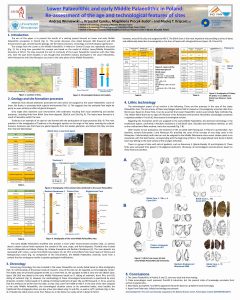Lower Palaeolithic and early Middle Palaeolithic in Poland: Re-assessment of the age and technological features of sites
Andrzej Wiśniewski1, Krzysztof Cyrek2, Magdalena Procyk-Sudoł2, Maciej T. Krajcarz3
1 – Institute of Archaeology, University of Wrocław, Szewska 48, 50-139 Wrocław, Poland · 2 – Institute of Archaeology, Nicolaus Copernicus University in Toruń, Szosa Bydgoska 44/48, 87-100 Toruń, Poland · 3 – Institute of Geological Sciences, Polish Academy of Sciences, Research Centre in Warsaw, Twarda 51/55, 00-818 Warszawa, Poland
Little is known about the transition from the Lower to the Middle Palaeolithic in Poland. Numerous questions without answers resulted from the limited value of chronometric and archaeological data. This paper aims to present the preliminary summarization of current state of knowledge concerning chronology and technological features of finds from Poland related to this transitional period.
So far over 20 Lower Palaeolithic sites, dated to between MIS 13 and MIS 8, have been recognized in Poland. Whilst the age of the mentioned spots is mainly based on litho-stratigraphical assessments. The confrontation of the stratigraphy of the findings with the chronometric dates (OSL and U-series) or biostratigraphic records indicates that only very few sites should be correlated with the Lower Palaeolithic [1,2]. Those sites, documented in the context of fluvial and slope sediments contain scarce remains of fauna. They comprised rather small lithic inventories (<400 items) with flakes, cores, and marginal retouched tools and some might contain pseudo artefacts. Unipolar and multidirectional core reductions were recorded.
Although the total number of early Middle Palaeolithic sites is lower (~11), their cognitive value is higher. While they represent both cave and open-air sites, the former ones, including Biśnik Cave (layers 19a-14), Nietoperzowa Cave (layers 14-16) and Ciemna Cave (layers 17/IX) [3- 5] provided more reliable data concerning the age and environmental conditions of the occupation. Chronometric dates and biostratigraphic data indicate that these finds are mostly corelated with MIS 7 and MIS 6. Those small inventories (<100 items) contain traces of using several methods of Levallois system, Kombewa and discoidal methods with the domination of the unifacial tools. Only at Biśnik Cave asymmetric bifacial-backed tools were recorded which were attributed to the oldest phase of Central European Micoquian. Except for Biśnik Cave, the presence of such old bifacial tools has not been confirmed.
This work was financially supported by the National Science Centre, Poland (grant number 2020/39/B/HS3/02277).
References: [1] Krajcarz, M.T., Bosák, P., Šlechta, S. et al., 2014. Sediments of Biśnik Cave (Poland): Lithology and stratigraphy of the Middle Palaeolithic site. Quat. International 326–327, 6–19. [2] Wiśniewski, A., 2016. The First humans. Societies of the Lower and Middle Palaeolithic. In: Kabaciński, J. (Ed.), 500,000 – 5,500 BC, The Past Societies. Polish Lands from the First Evidence of Human Presence to the Early Middle Ages. Institute of Archaeology and Ethnology, Polish Academy of Sciences, Warszawa, pp. 45–96. [3] Valde-Nowak, P., Alex, B., Ginter, B. et al., 2014. Middle Paleolithic sequences of the Ciemna Cave (Prądnik valley, Poland): The problem of synchronization. Quaternary International 326–327, 125–145. [4] Cyrek, K., Sudoł, M., Czyżewski, Ł. et al., 2014. Middle Palaeolithic cultural levels from Middle and Late Pleistocene sediments of Biśnik Cave, Poland. Quat. International 326–327, 20–63. [5] Madeyska, T., 1981. Środowisko człowieka w środkowym i górnym paleolicie na ziemiach polskich, Studia Geologica, 49.



